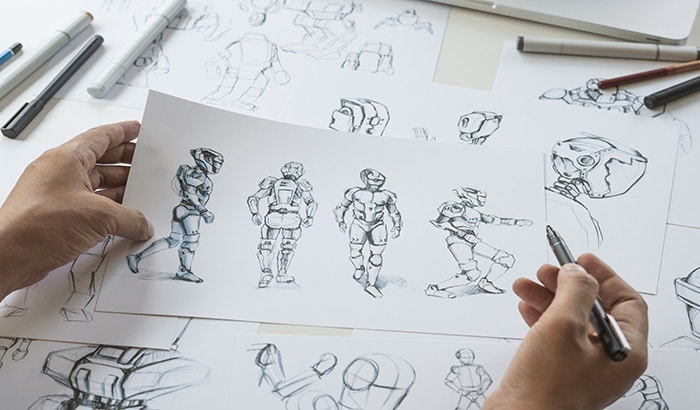Straight ahead action and pose-to-pose refer to the two drawing processes animators use to produce realistic and eye-appealing creations.
This is the fourth principle of animation and is the only principle that helps animators decide how to approach the process. Animation brings characters to life, appeals to an audience of all ages, and is readily used to boost product sales and conversion rates.
Today, we’re diving deeper into straight ahead action vs. pose-to-pose and sharing ways these techniques can benefit your business.
The 12 Principles of Animation
The 12 principles of animation were created by former Disney animators Frank Thomas and Ollie Johnston. They designed these principles to act as a guideline for creating more realistic characters. These 12 fundamentals form the basis of all animation work and include:
- Squash and stretch
- Anticipation
- Staging
- Straight ahead action and pose-to-pose
- Follow through and overlapping action
- Slow in and slow out
- Arc
- Secondary action
- Timing
- Exaggeration
- Solid drawing
- Appeal
Let’s take a closer look into the fourth principle, straight ahead action and pose-to-pose, which defines the two different ways to animate an action.
Straight Ahead Action
The straight ahead technique for drawing action means that you draw the entire scene in sequential order, frame-by-frame. Straight ahead action is spontaneous, as the animator uses intuitive emotion to drive what happens next.
Pros
- Illustrating actions from beginning to end produces smooth and fresh results.
- The process is unrestricted and unplanned, resulting in spontaneity and creative accidents.
- It results in a lyrical feel to the movement.
Cons
- It can become too unfocused as it’s difficult to plan ahead.
- It can be easy to accidentally emphasize the wrong action.
- It’s harder to keep proportions accurate.
Pose-to-Pose
The pose-to-pose technique is achieved by mapping out a few frames at a time to get the timing and motion right, and then going back and filling in the missing frames. Essentially, you start by drawing the beginning, middle, and ending frames first.
Pros
- It’s easier to keep things uniform.
- You have a bit more control within the scene.
- You can create a more dramatic effect.
- You can achieve well-timed animation.
Cons
- Pose-to-pose sometimes lacks fluidity.
- It produces a staged look.
- You don’t have quite as much creative flow, and as a result, fewer happy accidents can occur along the way.
How Animation Can Benefit Your Business
Animation is the key to transforming your business and increasing customer engagement. It is not only appealing, but animations can inspire your customers to make purchases and help maximize profits.
Here are a few more ways animated videos can benefit your industry:
- Animation is universally loved, so many people will watch and share it.
- Animated videos are engaging.
- They improve SEO because Google and YouTube love to promote animated videos.
- They are impressive and help you stand out from the competition.
- They will boost conversion rates and sales.
- They help clients better understand your product and brand.
- They expand your reach.
- They can enhance your email marketing.
Bring Your Animation Ideas to Life with REVITY Marketing Agency
At REVITY, our animators are well-trained in all 12 principles of animation, including straight ahead action and pose-to-pose. We work closely with clients to create custom animations and cutting-edge videos that are guaranteed to boost engagement and sales.
Contact us to see how REVITY can elevate your marketing strategy today!







